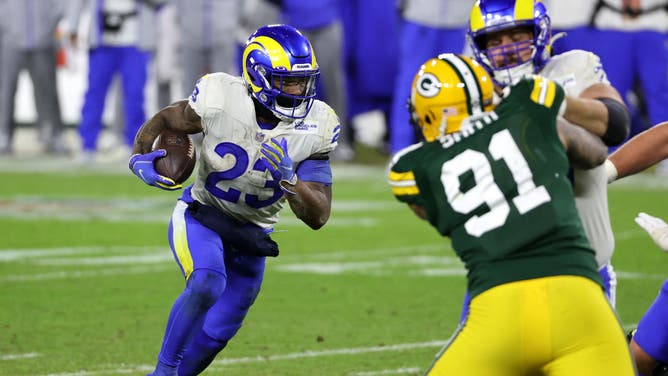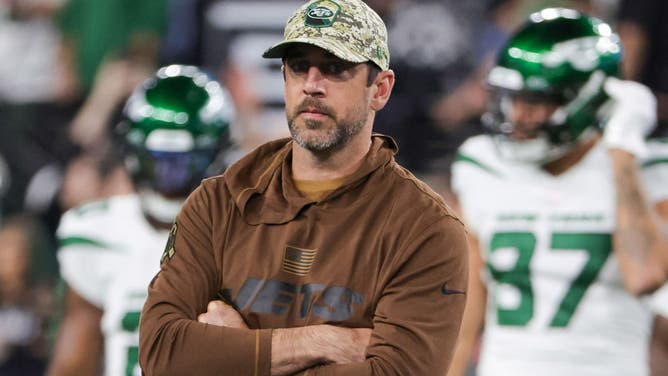For Aaron Rodgers, Return To Jets This Season Appears To Be About More Than Just Trying To Win Super Bowl | Dan Zaksheske
When Aaron Rodgers tore his Achilles tendon on the fourth play of his New York Jets career, everyone (myself included) referred to it as a "season-ending" injury. After all, players who tear their Achilles virtually never return the same season.
The only NFL player to ever do so was former Los Angeles Rams running back Cam Akers. Unlike Rodgers, Akers tore his Achilles during training camp in mid-July. At the time, outlets reported his injury as "season-ending."
Of course, because prior to Akers no NFL player had ever returned to the field in fewer than eight months.

Aaron Rodgers saw first-hand what a quick Achilles tear recovery looks like when Cam Akers of the Los Angeles Rams returned in less than six months and faced the quarterback's Green Bay Packers in the NFC Divisional Playoff. (Photo by Dylan Buell/Getty Images)
However, Akers underwent the SpeedBridge surgical procedure, which cut down his recovery time. Aaron Rodgers had the same procedure in September.
Akers tore his Achilles on July 20 and made his season debut in the team's final regular season game on January 9.
Aaron Rodgers is targeting a mid-December return. That would represent just three months from the time of his Achilles tear. That's nothing short of miraculous, if it happens.
Returning to the New York Jets this season doesn't make sense, and that's exactly why Aaron Rodgers is determined to do it
The Jets are currently 4-5 after back-to-back losses, one game behind Cincinnati and Houston for the final AFC Wild Card spot and two games behind the AFC East-leading Miami Dolphins.
If Rodgers were to return in mid-December, that puts his first game likely on December 17 against the Dolphins. That means the Jets have four more games with Zach Wilson under center.
They face the Bills, Dolphins, Falcons and Texans in those games. The Jets figure to be underdogs -- likely significant -- in at least three of them. Even if they manage to win two of those contests, they'd be 6-7 with four games to play in a crowded AFC.
The chances that the Jets makes the playoffs this season are not high.

Quarterback Aaron Rodgers of the New York Jets stands on the field during warmups before a game against the Las Vegas Raiders. (Photo by Ethan Miller/Getty Images)
Obviously, Rodgers wants to return to the team and be the hero who helps them defy the odds and reach the postseason.
But, he'd return to a team with a terrible offensive line on a left leg that would be nowhere near 100%. We already saw what it looks like when a star quarterback plays on a bad calf. Bengals signal-caller Joe Burrow played through a strained right calf and the team struggled to a 1-3 start.
Crucial differences between Cam Akers, Joe Burrow, Aaron Rodgers
The differences between Aaron Rodgers and both Cam Akers and Joe Burrow are important. As a running back, Akers needs both legs equally.
As a quarterback, Rodgers' left leg is slightly less important than his right. If he needed to "drive" off his left leg to throw three months after Achilles surgery, it likely wouldn't be possible.
Burrow was able to play through a right calf strain and it badly hampered his ability to both move and throw. Rodgers ability to move would be severely limited, but it probably won't have as much of an effect on his ability to throw. Though, not being able to fully finish his throwing mechanics will have an impact.

Cincinnati Bengals quarterback Joe Burrow struggled early this season when he played through a calf injury. (Photo by Frank Jansky/Icon Sportswire via Getty Images)
Those are the positive sides. The negative side is that Cam Akers tore his Achilles less than one month after his 22nd birthday. Aaron Rodgers turns 40 on December 2. You don't have to be a medical expert to know that 22-year-olds recover from injury faster than 40-year-olds.
Even Burrow played through his injury as a 27-year-old. Rodgers and Burrow aren't an apples-to-apples comparison, obviously, but does help provide context.
What else is at play here?
In my opinion, Aaron Rodgers doesn't just want to return to the field to chase a Super Bowl trophy. That's part of the equation, obviously, but not the entirety of his decision-making process.
Over the past few years, Rodgers has positioned himself as a bit of a health expert. He took a bold (and ultimately correct) stance on the COVID-19 vaccine. In addition, he frequently uses his platform to talk about things like alternative medicine.
He's talked about indulging in psychadelic drugs for their ability to help his mental state. He takes his health very seriously, which is important as an aging professional athlete.
Tom Brady adopted a rigid health protocol that helped him remain one of the best quarterbacks in the NFL into his age-45 season.
He even used that to write a book, The TB12 Method (subtitled: How to Achieve a Lifetime of Sustained Peak Performance), and launched his own health and fitness line of products. Of course, winning seven Super Bowls didn't hurt.

Tom Brady poses during the TB12 Grand Opening Event at the TB12 Performance & Recovery Center. (Photo by Nic Antaya for The Boston Globe via Getty Images)
Part of Tom Brady's "brand" was his highly-rigorous healthcare routine. The same goes for Aaron Rodgers.
While Rodgers won't win seven Super Bowls like Brady did, he can do something Brady -- nor anyone else -- has ever done: return to an NFL field three months after suffering a torn Achilles tendon.
Don't think for one second that isn't part of Rodgers' desire to come back this year. Even if the team doesn't have a chance to win the Super Bowl, I think Rodgers determination to prove everyone wrong fuels him just as much as winning. Perhaps more.
That drive to prove the doubters wrong is very powerful. If you've ever felt it, you know.
That's why I wouldn't bet against Rodgers returning this season.
Whether he can win the Super Bowl or not.